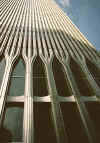 |
New York
Architecture Images- Gone
World Trade Center 0-Main Commentary |
WTC 0-Main Commentary 1-why did it collapse? 2-images from September 11th, 2001. 3-more images 4-Timeline: World Trade Center chronology 5-Towers of Innovation 6-The work of Minoru Yamasaki 7-images of reactions from around the world |
|||||||||||||||||
|
architect |
Minoru Yamasaki | ||||||||||||||||||
|
location |
Church to West Streets, Liberty to Vesey Streets | ||||||||||||||||||
|
date |
1966-70 | ||||||||||||||||||
|
style |
International Style II | ||||||||||||||||||
|
construction |
|||||||||||||||||||
|
type |
Office Building | ||||||||||||||||||
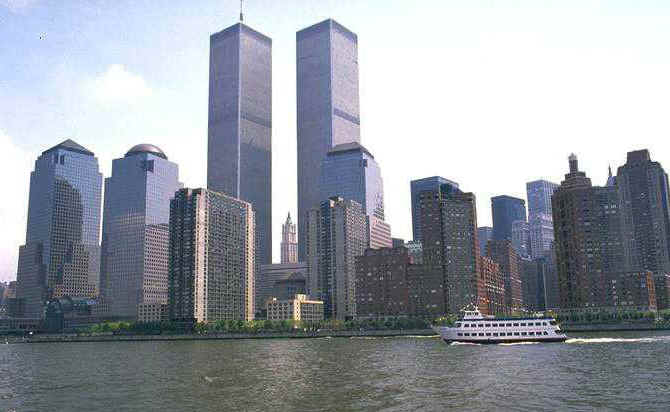 |
|||||||||||||||||||
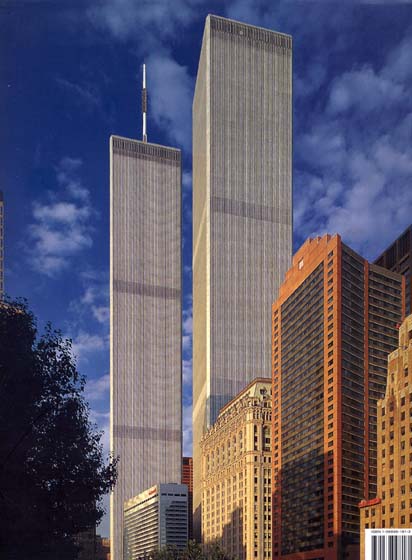 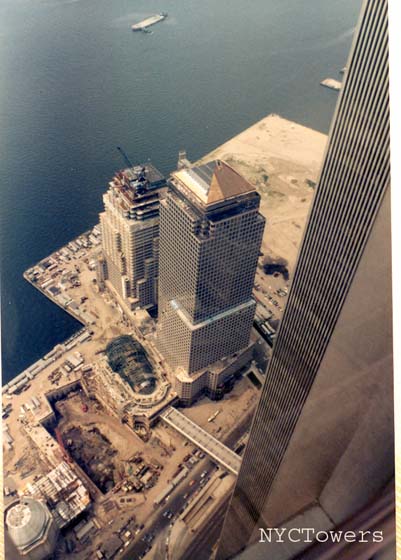 |
|||||||||||||||||||
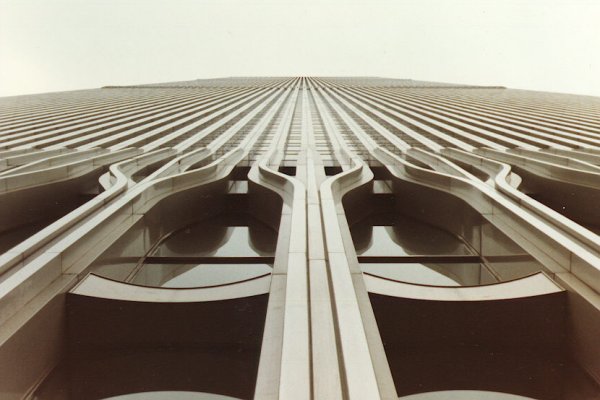 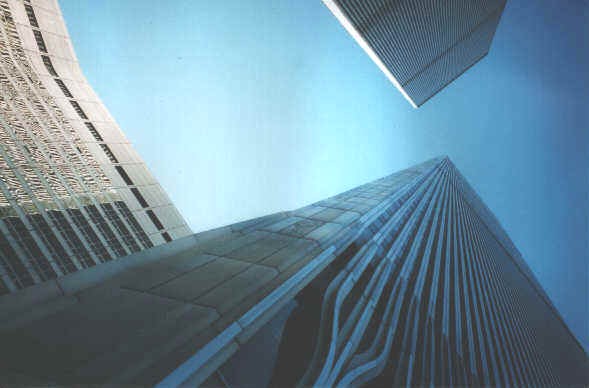 |
|||||||||||||||||||
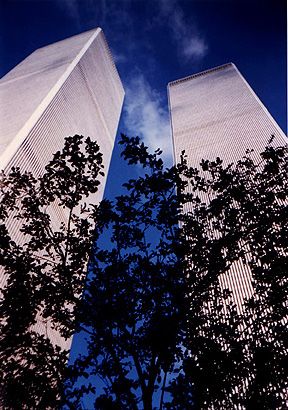 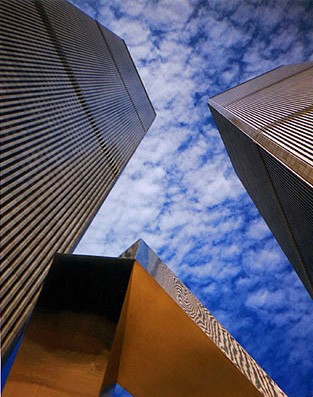 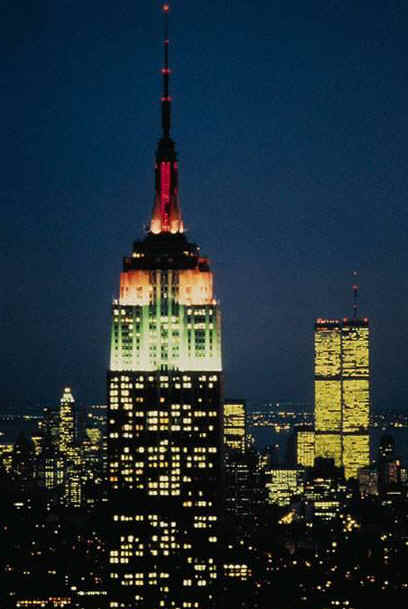 |
|||||||||||||||||||
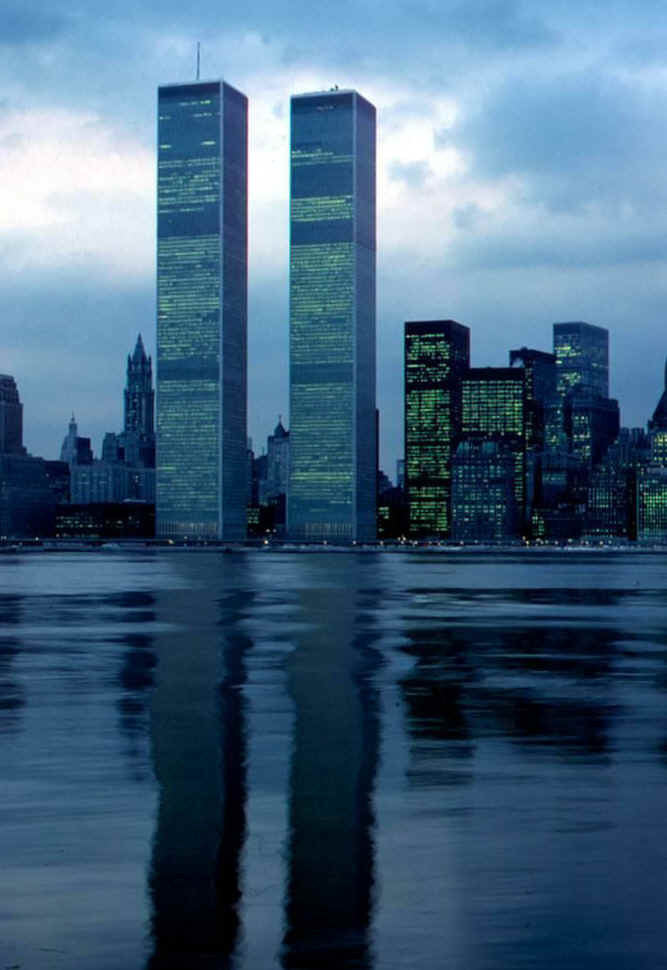 |
|||||||||||||||||||
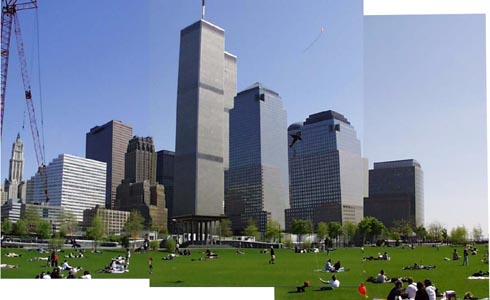 |
|||||||||||||||||||
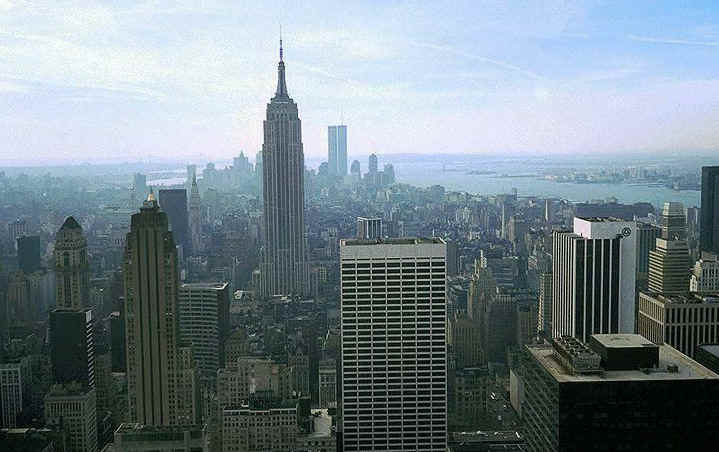 |
|||||||||||||||||||
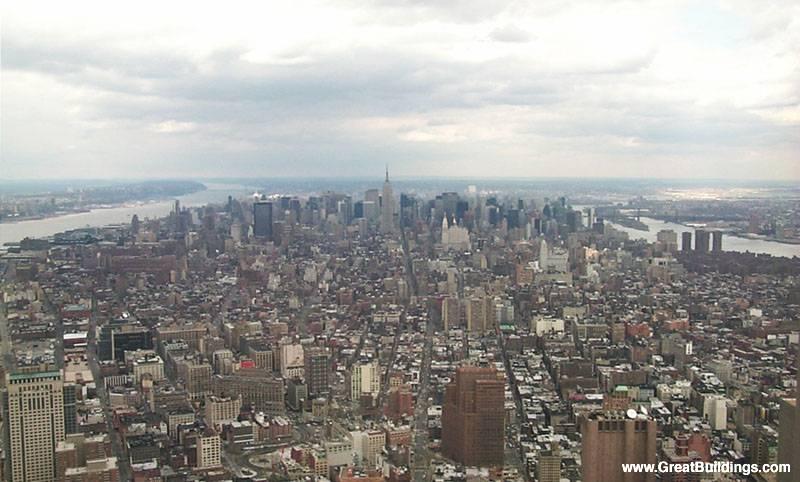 |
|||||||||||||||||||
| Click here for WTC gallery | |||||||||||||||||||
|
|
|||||||||||||||||||
      |
|||||||||||||||||||
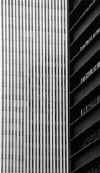 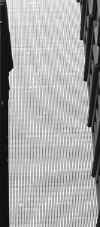 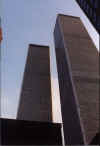 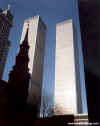 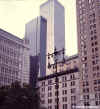 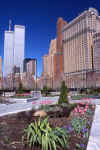 |
|||||||||||||||||||
  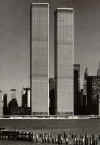 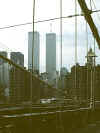  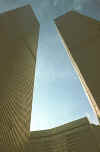 |
|||||||||||||||||||
 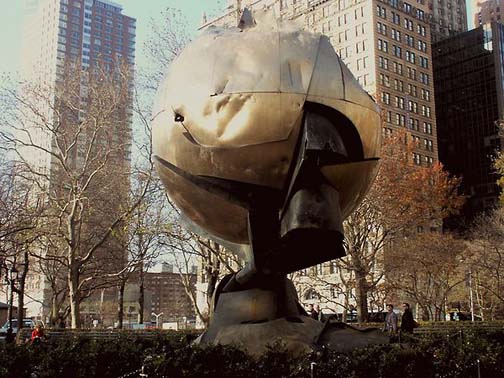 |
|||||||||||||||||||
| Picture of relocated damaged sculpture- ann marie hughes | |||||||||||||||||||
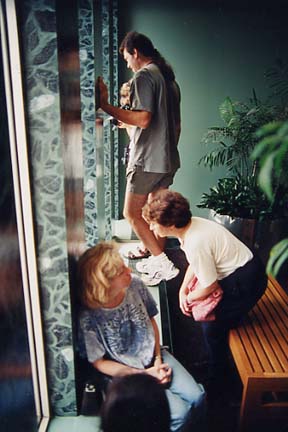 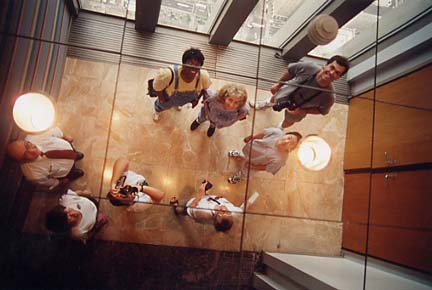 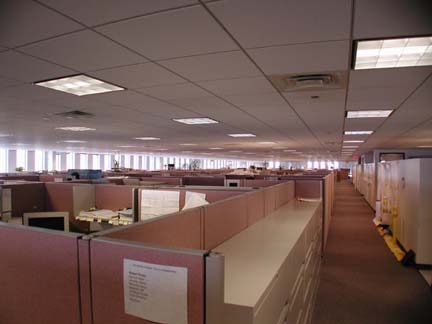 |
|||||||||||||||||||
| the
interior
|
|||||||||||||||||||
|
notes |
World Trade Center Commentary
"Yamasaki's commission to design the World Trade Center with the New York firm of Emery Roth and Sons...house(s) anyone and anything connected world trade. The program presented to Yamasaki, who was selected over a dozen other American architects, was quite explicit: twelve million square feet of floor area on a sixteen acre site, which also had to accommodate new facilities for the Hudson tubes and subway connections—all with a budget of under $500 million. The vast space needs and limited site immediately implied a high-rise development that...make(s) the adjacent drama of Manhattan's business tip seem timid in comparison.... "After studying more than one hundred schemes in model form, Yamasaki decided on a two-tower development to contain the nine million square feet of office space. One tower became unreasonable in size and unwieldy structurally, yet several towers became too approximate for their size and 'looked too much like a housing project'; whereas two towers gave a reasonable office area on each floor, took advantage of the magnificent views, and allowed a manageable structural system. The twin towers, with 110 floors rising 1,353 feet, ... (are) the tallest in the world. From observation decks at the top of the towers it...(is) possible to see 45 miles in every direction....One distinct advantage of the project's enormity is the architectural opportunity to advance the art of building. Yamasaki re-examined the skyscraper from the first principles, considering no ground so hallowed that it could not be questioned, especially in view of the potential of modern technology. The usual economic prohibition on 'custom-made' was out, as virtually anything made for the Center would automatically become a stock item. 'Economy is not in the sparseness of materials that we use,' said Yamasaki of his $350 million estimated cost, 'but in the advancement of technology, which is the real challenge.' "The structural system, deriving from the I.B.M. Building in Seattle, is impressively simple. The 208-foot wide facade is, in effect, a prefabricated steel lattice, with columns on 39-inch centers acting as wind bracing to resist all overturning forces; the central core takes only the gravity loads of the building. A very light, economical structure results by keeping the wind bracing in the most efficient place, the outside surface of the building, thus not transferring the forces through the floor membrane to the core, as in most curtain-wall structures. Office spaces will have no interior columns. In the upper floors there is as much as 40,000 square feet of office space per floor. The floor construction is of prefabricated trussed steel, only 33 inches in depth, that spans the full 60 feet to the core, and also acts as a diaphragm to stiffen the outside wall against lateral buckling forces from wind-load pressures. "The other primary obstacle to be overcome in the skyscraper is the elevator system, and Yamasaki has shown himself equally imaginative here. A combination of express and local elevator banks, called a skylobby system, it is particularly efficient because it requires fewer elevator shafts—thus freeing approximately 75 percent of the total floor area for occupancy; had a conventional elevator arrangement been adopted, only approximately 50 percent would have been available. The building has three vertical zones; express elevators serve skylobbies at the forty-first and seventy-fourth floors; from these, and from the plaza level, four banks of local elevators carry passengers to each of the three zones. "From the outset, Yamasaki believed that there should be an open plaza from which one could appreciate the scale of the towers upon approach. There is little or no sense of scale, for instance, standing at the base of the Empire State Building. Yamasaki's plaza...(is) sheltered from the river winds and contained by five-story buildings which...house shops, exhibition pavilions and a 250-room hotel." "'The World Trade Center should,' Yamasaki said, 'because of its importance, become a living representation of man's belief in humanity, his need for individual dignity, his belief in the cooperation of men, and through this cooperation his ability to find greatness.' " — from Paul Heyer. Architects on Architecture: New Directions in America. p194-195. For a detailed story of the World Trade Center planning process, please see our article page Casting Giant Shadows: The Politics of Building the World Trade Center. The Creator's Words "There are a few very influential architects who sincerely believe that all buildings must be 'strong'. The word 'strong' in this context seems to connote 'powerful' — that is, each building should be a monument to the virility of our society. These architects look with derision upon attempts to build a friendly, more gentle kind of building. ... Although it is inevitable for architects who admire [the] great monumental buildings of Europe to strive for the quality most evident in them — grandeur, the elements of mysticism and power, basic to cathedrals and palaces, are also incongruous today, because the buildings we build for our times are for a totally different purpose." — Minoru Yamasaki. from Paul Heyer, Architects on Architecture: New Directions in America, p186. "I feel this way about it. World trade means world peace and consequently the World Trade Center buildings in New York ... had a bigger purpose than just to provide room for tenants. The World Trade Center is a living symbol of man's dedication to world peace ... beyond the compelling need to make this a monument to world peace, the World Trade Center should, because of its importance, become a representation of man's belief in humanity, his need for individual dignity, his beliefs in the cooperation of men, and through cooperation, his ability to find greatness." — Minoru Yamasaki Building Details 110 stories, 1353 feet (412 meters)
tall The site is 16 acres in lower Manhattan, with buildings grouped around a five acre central plaza. The site is bounded by Vesey Street on the north, Church Street on the east, Liberty Street on the south, and West Street on the west, about three blocks north of the New York Stock Exchange. Observation deck, South Tower, WTC 2, floor
107 (summer hours 9:30am to 11:30pm). Groundbreaking for construction was on August 5th, 1966. Steel construction began in August 1968. First tenant occupancy of One WTC was December, 1970, and occupancy of Two WTC began in January 1972. Ribbon cutting was on April 4, 1973. On Friday, February 26, 1993, a massive terrorist bomb was exploded in the Center's public parking garage, but the Towers survived. World Trade Center Disaster — Tuesday, September 11, 2001 On Tuesday, September 11, 2001, at 8:45am New York local time, One World Trade Center, the north tower, was hit by a hijacked 767 commercial jet airplane, loaded with fuel for a trans-continental flight. Two World Trade Center, the south tower, was hit by a similar hijacked jet 18 minutes later at 9:03am. (In separate but related attacks, the Pentagon building near Washington D.C. was hit by a hijacked 757 at 9:43am, and at 10:10am, a fourth hijacked jetliner crashed in Pennsylvania.) The south tower, WTC 2, which had been hit second, was the first to suffer a complete structural collapse at 10:05am, 62 minutes after being hit itself, 80 minutes after the first impact. The north tower, WTC 1, then also collapsed at 10:29am, 104 minutes after being hit. WTC 7, a substantial 47 story office building in its own right, built in 1987, was damaged by the collapsing towers, caught fire, and later in the afternoon also totally collapsed. The list of collapsed buildings (as confirmed by the New York Times through Saturday, 2001.0915) included all seven buildings of the World Trade center complex — including WTC 6, the U.S Customs House to the north; WTC 3, the 22 story Marriot World Trade Center hotel just west of Tower Two; and WTC 4 and 5, the Plaza Buildings to the east (although satellite images suggest much of WTC 5, the north Plaza Building, was still standing). Other nearby buildings were significantly damaged, including the St. Nicholas Greek Orthodox Church, and One Liberty Plaza, a 54 floor, 743' tall building across Church Street to the east. About 2800 people died in the disaster. At the time the recovery and site clearing process officially concluded on May 30, 2002, 1796 people remained unrecovered. 1.8 million tons of debris was removed from the disaster site. |
||||||||||||||||||
|
Inspiration Romantic Calling A Dream Is Born In Training Stepping Into the Void Spellbinding "Sentenced" Lifetime Pass
|
|||||||||||||||||||
|
|||||||||||||||||||
|
resources |
Sources on World
Trade Center
"
Reconstruction Complications Continue", by B.J. Novitski,
ArchitectureWeek No. 60, 2003.0827, pN1.1. "Casting Giant Shadows: The Politics of Building the World Trade Center", by Roger Cohen, 1990, online at GreatBuildings.com. AIA Guide to New York City. Times Books, June 2000. (NA 735.N5 A78 1988, p48-49.) ISBN 0812931076. — Eric Darton. Divided We Stand: A Biography of New York City's World Trade Center. Basic Books, 2001. ISBN 0465017274. Angus Kress Gillespie. Twin Towers: The Life of New York City's World Trade Center. Rutgers University Press, November 1999. ISBN 0813527422. — Bill Harris. The World Trade Center: A Tribute. Running Press, November 2001. ISBN 0762413158. — Paul Heyer. Architects on Architecture: New Directions in America. New York: Walker and Company, 1966. LC 66-22504. IBSN 0442017510. discussion p186, 194-195. — Out of print Lawrence A. Martin, University of Oregon. Slides from photographer's collection, September 1993. PCD.3235.1012.0545.020. PCD.3235.1012.0545.022. PCD.3235.1012.0545.021. Donald Martin Reynolds, Richard Berenholtz. Manhattan Architecture. NA 735.N5B47 1988. ISBN 013551987X. p18, 19, 36, 37, 96-99. Minoru Yamasaki. A Life in Architecture. New York: Weatherhill, 1979. NA737.Y3A2 1979. ISBN 0-8348-0136-1. LC 79-11561. drawing of site plan, p119. drawing of ground plan of a tower, p118. |
||||||||||||||||||